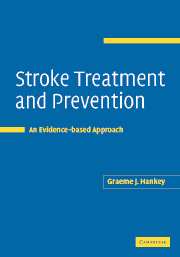Book contents
- Frontmatter
- Contents
- Preface
- 1 The size of the problem of stroke
- 2 Understanding evidence
- 3 Organised acute stroke care
- 4 General supportive acute stroke care
- 5 Reperfusion of ischaemic brain by thrombolysis
- 6 Augmentation of cerebral blood flow: fibrinogen-depleting agents, haemodilution and pentoxifylline
- 7 Neuroprotection
- 8 Treatment of brain oedema
- 9 Anticoagulation
- 10 Antiplatelet therapy
- 11 Carotid artery revascularisation
- 12 Lowering blood pressure
- 13 Lowering blood cholesterol concentrations
- 14 Modification of other vascular risk factors and lifestyle
- 15 Antithrombotic therapy for preventing recurrent cardiogenic embolism
- 16 Arterial dissection and arteritis
- 17 Treatment of intracerebral haemorrhage
- 18 Treatment of subarachnoid haemorrhage
- References
- Index
14 - Modification of other vascular risk factors and lifestyle
Published online by Cambridge University Press: 23 December 2009
- Frontmatter
- Contents
- Preface
- 1 The size of the problem of stroke
- 2 Understanding evidence
- 3 Organised acute stroke care
- 4 General supportive acute stroke care
- 5 Reperfusion of ischaemic brain by thrombolysis
- 6 Augmentation of cerebral blood flow: fibrinogen-depleting agents, haemodilution and pentoxifylline
- 7 Neuroprotection
- 8 Treatment of brain oedema
- 9 Anticoagulation
- 10 Antiplatelet therapy
- 11 Carotid artery revascularisation
- 12 Lowering blood pressure
- 13 Lowering blood cholesterol concentrations
- 14 Modification of other vascular risk factors and lifestyle
- 15 Antithrombotic therapy for preventing recurrent cardiogenic embolism
- 16 Arterial dissection and arteritis
- 17 Treatment of intracerebral haemorrhage
- 18 Treatment of subarachnoid haemorrhage
- References
- Index
Summary
Diabetes mellitus and glucose intolerance
Evidence
Risk factors for stroke
Diabetes mellitus and glucose intolerance are important risk factors for ischaemic stroke (Tuomilehto and Rastenye, 1999). Above a fasting blood glucose concentration of 4.9 mmol/l, there is a continuous association between fasting blood glucose levels and vascular disease; for every 1 mmol/l increase in fasting blood glucose there is a 21% (95% CI: 18–24%) increase in risk of stroke, 23% (95% CI: 19–27%) increase in risk of ischaemic heart disease events and 19% increase in cardiovascular deaths (Asia Pacific Cohort Studies Collaboration, 2004).
Effective strategies to reduce the risk of stroke in diabetics
Effective strategies to reduce the risk of stroke in diabetics include:
Preventing or delaying the onset of diabetes by appropriate lifestyle behaviours (to achieve target levels of risk factors) and perhaps use of the α-glucosidase inhibitor acarbose to improve insulin sensitivity (Chiasson et al., 2002, 2003).
Preventing atherogenesis by optimally controlling risk factors such as high blood pressure (Heart Outcomes Prevention Evaluation (HOPE) Study Investigators, 2000a,c), high blood cholesterol (Heart Protection Study Collaborative Group, 2003; Colhoun et al., 2004), high blood glucose (UK Prospective Diabetes Study (UKPDS) Group, 1998a,b) and smoking.
Preventing atherothrombosis, should an atherosclerotic plaque become eroded or rupture, with optimal antiplatelet therapy (Antithrombotic Trialists' Collaboration, 2002; Sacco et al., 2003).
Recanalising any accessible arteries which are stenosed and symptomatic by means of carotid endarterectomy (Rothwell et al., 2003).
- Type
- Chapter
- Information
- Stroke Treatment and PreventionAn Evidence-based Approach, pp. 308 - 329Publisher: Cambridge University PressPrint publication year: 2005



